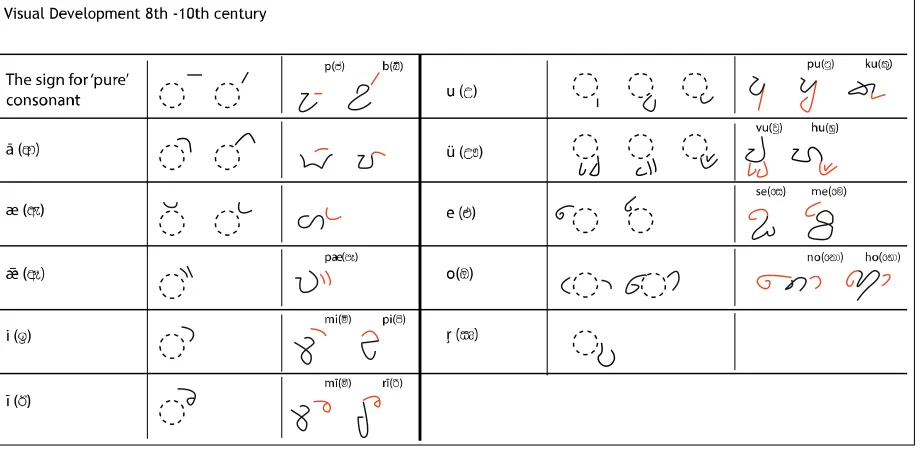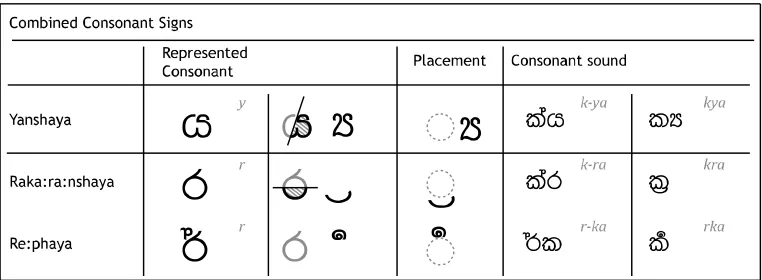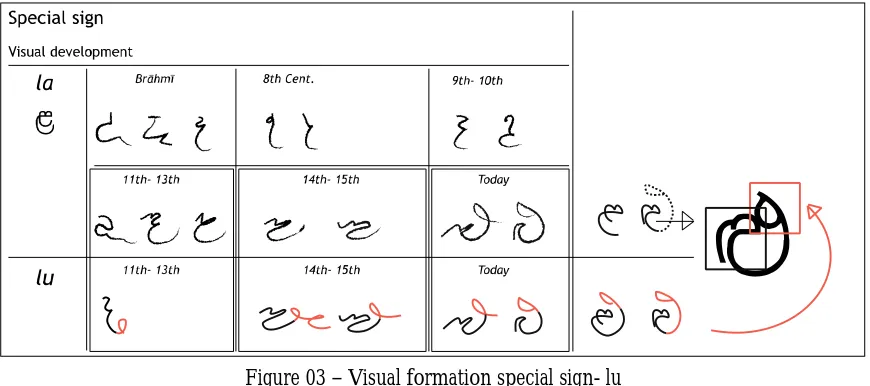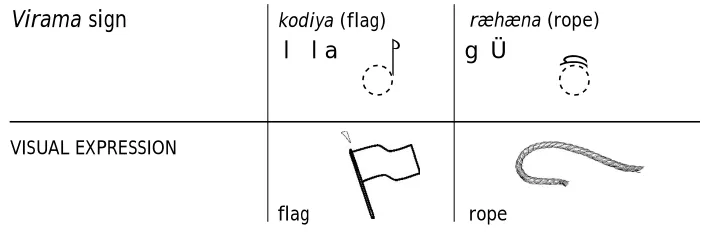ISSN: 2334-2986 (Print), 2334-2994 (Online) Copyright © The Author(s). All Rights Reserved. Published by American Research Institute for Policy Development DOI: 10.15640/jea.v5n1a9 URL: https://doi.org/10.15640/jea.v5n1a9
Anatomy of the Sinhala Letter
Sumanthri Samarawickrama
1Abstract
Anatomy of a letter can be defined as the vocabulary used to describe parts of a letter and its structural system that makes up the morphological characteristics of a certain typeface (Dalvi 2010: 61). This research studies the existing vocabulary and the non-existing vocabulary of the structural system of the Sinhala letter as the theory and literature on this area israre.The term ‘Sinhala letter’ describes all Sinhala lettersused today. The research is divided into two sections. First it examines the existing vocabularythrough a literature survey and cross-examines it by three experts. Secondly, through a visual analysis a list of distinguished features unique to the Sinhala letteris identified to bridge the gapof the non-existing vocabulary. Thefindings on this paper only discuss the first section; the existing vocabulary and the derivation of the terminology. This can be considered as an initial proposal to standardize a vocabulary for the subject of Sinhala typography.
Keywords: Sinhala Anatomy, terminology, typographic vocabulary, Sinhala letter
1.0 Introduction
Anatomy of typography is commonly spoken within the Latin alphabet due to its historical involvement of typographers, publishes, printers and type designerscomparatively, theSri Lankan printing industry comes to light only in the eighteenth century with scarce theory and literature on the anatomy of the Sinhala letter.Therefore, to advance the study on Sinhala typography, it is important to standardize a vocabulary. To observe the existing vocabulary that defines parts of the Sinhala letter and its structural system was conducted taking into account the works of three experts on epigraphy, language and standardization of language. In linguistic studies there are two types of sound; vowels and consonants and the two sounds are given a visual approach in typographic studies. Therefore the present study dividesthe vowels and consonants into five sections according to its visual form. Vowels – as letters, medial vowel sign, andconsonants - as letters, combined consonants and other special signs (Table 01). To understand the parts and the structural system of the Sinhala letter, the study considers the vowels and consonants as the focal visual form in section one and identifies other visual forms- around it (medial vowel sign), by it/ combined forms (combined consonants and consonants signs) and independent of it (other signs). While the focal visual form;‘letters’are discussed in section two and will be published by the author in an upcoming paper.
Table 01: Parts of the Sinhala letter – present study on existing vocabulary
Current study approaches the three experts through a literature survey and a cross-examination. It is focused on the vocabulary used to describe the medial vowel signs, combined consonants, combined consonant signs and other special signs.The medial vowel signs are visual symbols that represent vowel sounds attached to a consonant. Combined consonant are when two or more pure consonants are written together, either by binding two or more letters while thecombined consonant signs are referred as the re:phaya, raka:ra:ŋshya and the yaŋshaya. Other special sign/s is identified as the lu sign. Among several experts on the subject of epigraphy and language studies the most comprehensive authors’ were selected to cross examine with the third expert - the board of writers to the National Education Commission (NEC) on the standardization of the proportions of the Sinhala letter and the board of writers to the Ministry of National Language and Social Integration (MNLSI) on the application of ‘pili’ (s.pilla)tothe Sinhala letter.
2.0 Selection of experts and objectives: Epigraphic and Language studies
Epigraphic and paleographic research by pioneer authors H.C.P. Bell, P.E.E. Fernando, S. Paranvitana and,D M. de Zilva Wickremasinghe wasexamined and Fernando was selected as the expert to represent the category of epigraphy. He illustrates each letter and its visual development while the other authors speak of the letter within a broader area of grammar through phonology, morphology and syntax. One of the most elaborate descriptions on the evolution of the Sinhala scriptis explained in Fernando’s Origin and the Development of the Sinhala Script (2008).The expert explains the development of the visual formation of the Sinhala scriptuntil the 15th century ACEwhich can be recognized by anyone who can read it today. The visual development helps to identify what parts
(structural system) make up the Sinhala letter and the author takes this as the main point of reference in order to examine the existing terminology that is used to describe the features of the Sinhala letter.
The objective of the literature survey on the first expert is as follows: What are the parts that make up the Sinhala letter?
What are the partsthat have an existing vocabulary?
The second expert’s focus on language studies bridges the gap from where the first expert concludes(15th century ACE) to the present. Language studies use script in aspects such aslanguage form, language meaning, and language in context and documents Sinhala script and its practices today. The largest number of literature was found within the second expert of Language. Authors R. Arangala, V. Balagalle, A.V. Suraweera, T. Kariyawasam and J.B. Dissanayaka were referred to butnone other than J. B. Dissanayake speaks on typology. Therefore his work; Three publications by the author, newspaper article included in the reference and a personal interview were referred to extend the current research. Dissanayake express terminology in two stages. First he constructs the letter within five guidelines and divides them into ascenders, descender and baseline letters. He explains how the vowel signs are placed; either before, after, top and bottom. Second he gives a list of eight combined consonants defined as ‘conjunct letters’ (Dissanayake 2012:672-3) and five combined consonant signs described as ‘consonant strokes’ (Dissanayake 2012:491).
The objective of the literature survey on the second expert is as follows: What are the new additions to the script that make up the Sinhala letter What are the parts that have an existing vocabulary
2. Literature survey: Epigraphic and Language
Other special signs(oss) which assists in theidentification of the morphological characteristics that form the anatomy of the Sinhala letter. Within the five groups;the vowels, consonantsand CCare represented by its sound therefore there is no significant terminology, but theMVS, combined consonant signs (CCS) and OSS have a specific terminology used in thecurrent study. The terminology used by Fernando is compiled in table 3with the findings of the other experts for cross analysis.
Medial vowel signs
The visual development of the MVS explained by Fernando helps one to know where they were initially placed (located; top, bottom, before or after). The strokes that illustrated these signs took different shapes (circular, oblique) due to the structural development of the vowel bearer; consonants. During 8th -10th Century ACE the script
shows several structural changes and takes its current form by the 15th Century ACE.A sample of this visual
development is illustrated in figure 01.
Figure 01 – Visual formation of selected medial vowel signs of 8th -10th century
Combined consonants
Table 02 – List of combined consonants by all three experts Combined consonant signs
The combined consonant signs re:phaya, raka:ra:ŋshya and the yaŋshayais grouped under combined consonantsbecause of its visual construction is more specific to the consonants y(h) and ra(r). The re:phaya is a replacement of the hal ra(r) before a consonant. Raka:ra:ŋshya is placed when the hal ra(r) is written after a consonant. This is visualized with the bottom half of the ra(r) attached to the bottom right of a consonant. Yaŋshaya is also similar to the raka:ra:ŋshya but the half of the y(h) is a horizontal split (figure 02).
Figure 02 – Visual formation of the combined consonant signs Other special sign/s
Figure 03 – Visual formation special sign- lu 2.2 Bridging the literature gap and identifying the variables
The research concentrated on identifyingthe visual features of the Sinhala letter and the terminology in relation to it. The visual forms; MVS, CC, CCS and OSS dating upto the 15th century wereextracted from the first
expert and was noted down. Subsequently, the language research of the second expert facilitated in bridging the gap in the formation of Sinhala letters from the past to the contemporary times At the conclusion of the literature survey,a summarizedlist of thepartsthat make up the Sinhala letteris distinguished. The list is complied in table 03 as the selected variables andcross-examined with the third expert on standardization of language to identify other or similar terms used to describe them. Two institutions; National Education Commission (NEC) and the Ministry of NationalLanguages and Social Integration(MNLSI) is identified as the third expert . A publication from the NEC on the standardization of the proportions of the Sinhala letter in 2005 and a publication by the board of writers to the MNLSI on the application of ‘pili’ (s.pilla) on the Sinhala letter in 2013 were selected. Both books are structured as a visual representation on how the Sinhala letter needs to be structured. The NEC publication illustrates all the letters in the alphabet and the medial vowel signs within five guidelines. The only terminology used within the publication is the medial vowel signs and a few selected combine consonant signs included in table 03. The vowel signs for o, ō, ŗŗ, ai,and the CCS re:phayais also not visually presented. The missing MVS were introduced in the MNLSI publication under two sections; a). defines the MVS and 2). on the special Sinhala letters and strokes, and within this section we find selected MVS, a list of CC and CCS. The terms that defined these visuals extends totable 03and gives a complete list of variables by all three experts.
3 Analysis on existing vocabulary
To standardize a vocabulary to describe the anatomy of the Sinhala letter, first the author analyses the variable in table 03and divides the variables according to medial vowel signs, combine consonant signs and other special signs.
3.1 The medial vowel signs
All vowels are represented visually with one medial vowel or with a combination of signs. Taking this into consideration and the behavior of the hal sign (virāma sign) author discusses the use of terminology under three sub-groups as:
Group one : ā(wd), æ(we),ǣ(wE),i(b),ī(B),e(t),u(W),ū(W!),ŗ(R),ŗŗ(RD),au(T!) Group two : a(w) and hal sign
3.1.1 Variables:medial vowel sign - group one :ā, æ, æ:,i,ī,e,u,ū,ŗ,ŗŗ,au
Vowels are grouped as short and long according to its pronunciation. The MVS that represents these sounds too are termed accordingly, as keti (meaning short) and deerga, degu, and dik(meaning long, extended). In selected vowels, the visual expression of short and long vowel signs are termed according to its placement (location: side, top or bottom). ā(wd), æ(we),ǣ(wE)- æla (meaning slant, side), i(b),ī(B)- is (meaning head – symbolically top), u(W),ū(W!)- pa (meaning foot, feet – symbolically bottom). Therefore the long vowel adopts its terminology from its expression of voice and visual; degu ada pilla (voice expression: degu; long and as visual expression: æla; side) and this practice is common to vowels ǣ(wE),ī(B),ū(W!) (Figure 04).In the case of ṝ (RD) the long sound is expressed by repeating the sign (figure 05). Terminology that illustrates the voice expression for the long vowel is common within all three experts yet the first expert uses the expression language origin; Sanskrit term deerga, second and third experts uses Sinhala terms degu, dik. The term keti (short) is only used by the third expert and not a collective expression to signify the short vowel sound. .
Figure 04 – voice and visual expression in terminology
Another form of visual expression is identified in vowels e(t),ṛ(R),au(T!).The vowel sign e(t)is represented with a kombuva (p.kombu) (meaning horn: musical horn or instrument of that shape).The sign of ṛ(R)is similar to the æla pilla but with a gætaya (p.gæta)(meaning knot) so it is termed as the gæta pilla (side sign with a knot) and practiced within the second and third experts. The visual expression of vowel sign au(T!)is represented with a gayanukitta. This sign illustrates a rotated ga(.)and written next to a consonant.Gayanukitta (meaning, the pilla with form of the letter ga). The term kitta originates from the Sinhala term Kruthya- lD;H(meaning function) yet due to semantic change in language it means form- Svarupa. There is no other term to define it except the term au pilla used by the second expert.
The vowel signs of u(W), ū(W!) have had two visual forms from its inception and the third expert uses additional terms as kon (meaning corner) and vak (meaning curve – deriving from the term vakraya ) in describing its visual expression.
Figure 06 –visual expression in terminology
3.1.2 Variables: group two : a(w)and hal sign Sinhala language is classified as an abugida, and it means that all consonants have an inherent a sound to it. Therefore with the application of the hal sign orvirāma(meaning stop, pause) the consonant stops the inherent a sound and achieves its pure consonant sound and is known as hal kirima (figure 09). Nevertheless there are two visual forms to signify the pure consonant sign or the ‘pause mark’ due to its placement of selected consonants. When the sign is attached to an ascending consonant it is illustrated as a ræhæna (meaning rope) and when placed on to a descending or a base consonant it is illustrated as a kodiya (meaning flag). The visual form derives out of space constrains and is illustrated in figure 05.
Figure 07 –visual development of the hal sign
When the same visual form of the hal orvirāma sign is used in vowels ta" ´"this sign is known as a hal lakuna (meaning ‘lengthening mark’) as the vowel makes a long sound. In the application of ē vowel, the sign takes two visual forms (kodiya, ræhæna) but when the ō vowel is applied it is placed on top of the æla pilla resulting in one visual form (kodiya).
Figure 08 –visual expression in terminology
Visual development above top line
l l a g Ü
Virama sign kodiya (flag) ræhæna (rope)
rope flag
The terms ræhænaand kodiya arevisual expression of the signused by the second and third expert, while the second expert uses another term al lakuna to express the language sound.
3.1.3 Variables: medial vowel sign - group three : ē(t),o(T),ō(´)
The third group represents vowel signs that are made with a combination of signs. The common features within the three vowels are the kombuvabefore the consonant and the first expert uses another term e karaya(meaning doing act, that which makes the sound) for the vowels e and ē. The signson or after the consonants are named as ā pilla also known as ākaranshaya, æla pilla, viramaya, hal kirima in respective of each vowel.The term dik æda pilla is used by the third expert when the lengthening mark is on the æda pilla, as it is only practiced on the application of the vowel ō. The second expert breaks this combination and gives one term for each vowel sign as ē pilla, o pilla, ō pilla. Another expression is identified when the second and the third expert introduces two terms;us pilla (us meaning high, elevated)and udu pilla (udu meaning upper part) to represent the hal sign for the vowel ta" visual expression by its terminology. By analysing all the terms used by the three experts several expressions are noted. The first expert notes the existence of most vowel signs yet the publication does not give terms for the MVS R" RD"´and T! Therefore table 02 indicates it as ‘no term’.
Figure 09 –Virama sign- pause mark and lengthening mark
The common expression used for most vowel signs is the term pilla (meaning branch) since it branches out of the consonant and to signify this, the second expert uses the term pilla after every vowel sound as a pilla, æ pilla, æ: pilla, ē pilla, o pilla, ō pilla etc. Yet most terminology used by the second and the third expert are similar.
3. 2 Combined consonant signs and other special signs
The identified combined consonant signs were the re:phaya,raka:ra:ŋshya and the yaŋshaya. Yet the second expert introduces two more signs as țaka:ra:ŋshaya and Daka:ra:ŋshaya.A:ŋshaya (meaning half) depicts the visual expression of half of the letter ya and ra(Figure 02).Meanwhile the signs for țaka:ra:ŋshaya and Daka:ra:ŋshaya introduced by the second expert does not contain half of ț and d. The term re:phayarepresents its voice sound r sound and the terminology of visual expression (half of the letter ra) is inraka:ra:ŋshya. While the special sign lu is an expression of voice.
3.3. Observation and findings
At the conclusion of the study several aspects were achieved to establish the existing vocabulary that defines the anatomy of the Sinhala letter. The findings are as follows:
Identifying parts that make up the Sinhala letter
The literature survey established all parts that make up the Sinhala letter with its five division on visual form. Vowels – as letters, medial vowel sign, and consonants - as letters, combined consonants and other signs. As a result all parts (figure 07) excluding the letter; vowels and consonants were identified as parts of the
morphological characteristics of the Sinhala letter. Documenting existing terminology
Literature on the Sinhala letter is limited to the selected experts area of specialization; epigraphy, language and standardization and not specific to the subject of Sinhala typography, therefore to
advance the study on Sinhala typography the list of existing nomenclature becomes a pioneer study. This large pool of nomenclature is a result of the current practice of using several terms to
describe a single variable and the variables are not unified to define the anatomy of the Sinhala letter. Each variable had derived out of three aspects as visual expression, voice expression and the expression of language origin which can be used to create new nomenclature and to establish
a standardized vocabulary. Existing vocabulary
Variables Expert one
:
Epigraphy
Expert two : language
Expert three : Standardi zation of language Medial vowel signs
The sign for ‘pure’ consonant
Hal kirima - N,AlsÍu y - y
Viramaya – úrduh y - y
Kodiya - fldäi - y y
Hal Pilla - N,A ms,A, - y -
Rahena - ?Nek - y y
Al lakuna - w,A ,l=K - y -
ā (wd), ā pilla - wd ms,A, y y -
ā la pilla - we, ms,A, y y y
ā karanshaya - wdldrdxYh y - -
æ (we) æda pilla - weo ms,A, y y y
Keti æda pilla - flá weo ms,A, - - y
ækaranshaya - weldrdxYh y -
ædaya weoh y y -
æ pilla - wems,A, - y -
degu ǣda pilla - oS.= weoms,A, - y y
dik ǣda pilla - oSla weoms,A, - - y
ǣpilla - wEms,A, - y -
i(b) is pilla - biAms,A, y y y
Keti is pilla - flá biAms,A, - - y
i pilla - bms,A, - y -
ī(B) deerge īs pilla – oSra> biAms,A, y - - degu īs pilla – oS.= biAms,A, - y y Dik īs pilla - oSla biAms,A, - - y
ī pilla - Bms,A, - y -
u (W) Pa pilla - mdms,A, y y -
Keti pa pilla - flá mdms,A, - - y
u pilla - W mdms,A, - y -
Keti kon pa pilla - flá fldka mdms,A, - - y
Keti vak pa pilla - flá jla mdms,A, - - y
ü (W!) deerga pa pilla - oSra> mdms,A, y - -
degu pa pilla - oS.= mdms,A, - y y
ü pilla - W! mdms,A, - y -
Dik kon pa pilla - oSla fldka mdms,A, - - y
Dik vak pa pilla - oSla jla mdms,A, - - y
e (t) e karaya – t ldrh y - -
kombuwa – fldïnQj y - y
e pilla – t ms,A, - y -
ē (tA) ē karaya – t ldrh y - -
+
viramaya – úrduh y - y
hal kirima - N,AlsÍu y - -
Us pilla – Wia ms,A, - y y
Udu pilla – WXq ms,A, - - y
e pilla – tA ms,A, - y -
o (T) e karaya – t ldrh y - -
kombuva – fldïnQj y - y
+
ā pilla - wd ms,A, y - -
æla pilla - we, ms,A, y - y
ākaranshaya - wdldrdxYh y - -
o pilla – T ms,A, - y -
ō (´) NO TERM y - -
kombuva – fldïnQj y y y
+
dik ada pilla - oSla weoms,A, y y y
ō pilla – ´ ms,A, - y -
ŗ(R) NO TERM y - -
Gata Pilla - .eg ms,A, - y y
ŗ Pilla – R ms,A, - y -
keti gata Pilla - flá .eg ms,A, - - y
ŗ(RD) none - -
Degu gata Pilla - oS.= .eg ms,A, - y y
A list of nomenclature that defines all medial vowel signs combined consonant signs and other special signs by three experts are documented, proving that there is no unified terminology needed to establish the anatomy of the Sinhala letter.
Derivation of the existing terminology
The derivation of the existing terminology was identified as expressions of visual and sound. This finding can be used todescribe the second part of the study on Sinhala letter: vowel and consonants, to develop new nomenclature for the identified features of the Sinhala letter.
List combined consonants and signs
As an outcome, findingson the structural system of the Sinhala letter includescombined consonants. All the combined consonants used by the experts are documented for the benefit of the subject of Sinhala typography. References
Arangala, R., (2004) Emergence of Modern Sinhala Literature, S. Godage and Brothers, Colombo.
Dalvi, G., (2010) Conceptual model for Devanagari typefaces. PhD Thesis, Industrial Design Centre, Indian Institute of Technology Bombay.
Dalvi, G., (2010)
De Silva, H., (1972) Printing and publishing in Ceylon, Sri Lanka national Commission for UNESCO, Sri Lanka. Disanayaka, J. B., (2006) Sinhala Graphology, Sumathi Publications, Kalubovila.
Disanayaka, J. B., (2012) Encyclopaedia of Sinhala Language and Culture, Sumathi Publications, Kalubovila. Disanayaka, J. B., (2012) Sumathi Publications, Kalubovila.
Dik gata Pilla - oSla RD ms,A, - - y
au (T!) none - -
Gayanu kiththa - .hkqls;a; - y y
au Pilla - T! ms,A, - y -
ai (ft) none - -
Kombu deka – fldïnQj fol - - y
ai Pilla - ftms,A, - y -
Combined consonant signs
Yansaya - hxYh y y y
Rakaranshaya - rldrdxYh y y y
Repaya - fr®mh y y y
Takaranshaya - gldrdxYh - y -
Fernando, P. E. E., (2008) Origin and development of the Sinhalese script, Sri Lanka national book development council, Battaramulla.
Gunasekera, B., (1999) The evolution of the Sinhalese script from the 6th to the 10th century, S. Godage and
Brothers, Colombo.
Hemapala, N., (1998) Sinhala mudranaya ha puwathpath (Sinhala printing and newspapers), Thisara Prakashakayo, Dehiwala.
Kularatne, T., (2006) History of printing and publishing in Ceylon 1736-1912, Sridevi printers, Dehiwala.
Kumar, U. D., (2010) Transformation of Tamil letterforms from Palm leaf manuscripts to early Letterpress printing, PhD Thesis, Industrial Design Centre, IIT, Bombay.
Lankage, J., (1996) Sinhala warna malawe wikashanaya (Evolution of the Sinhala alphabet), S. Godage and Brothers, Colombo.
Ministry of national language and social integration, Presidential task force for a trilingual Sri Lanka and Ministry of Public administration and home affairs, (2013) Sinhala Letter, Sri Lanka
Mudiyanse, N., (1965) Sinhala akuruwala ithihasaya (History of the Sinhala letters), University of Kelaniya press, Kelaniya.
National Education Council, (2005) Sinhala akuru livima sandaha margapupdesha(Guidelines for Sinhala letter writing), Sri Lanka
Noordzij, Gerrit (2005) The stroke: theory of writing Hyphen Press, London
Paranavitna, S., (1970) Inscription of Ceylon, (Vol.I), Department of Archeology, Moratuwa. Paranavitna, S., (1983) Inscription of Ceylon, (Vol.II), Department of Archeology, Moratuwa. Tracy, W., (1986) Letters of credit, David R. Godine, Boston.





